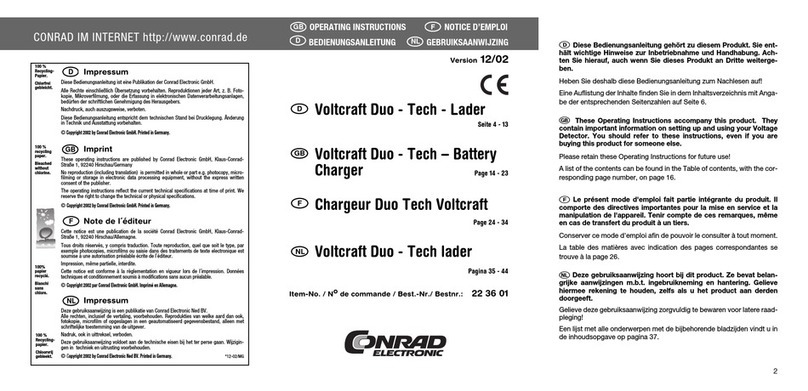19
La capacité d’un accumulateur est en effet indiquée par les principaux fabricants
pour un facteur C/3 angegeben, c’est-à-dire qu’un accumulateur de par exemple
1200 mAh sera capable de fournir 1200 mAh sous un courant de décharge inférieur
ou égal à 400 mA (= C/3). Quand toutefois un fabricant donne pour un accumulateur
de 1200 mAh un facteur de C/10 (= 120 mA), il est peu probable que cet accumula-
teur soit encore capable de fournir 1200 mAh sous un courant de 400 mA ! D’où l’on
peut déduire que l’accumulateur dont la capacité est spécifiée avec un facteur C/10
est le moins bon.
Les accumulateurs se déchargent peu à peu. On parle de décharge spontanée.
2. Prescriptions de sécurité
Ce chargeur est construit en classe de protection 2 et ne doit être utilisé que sur un
réseau alternatif de 230V.
Ce chargeur permet de charger simultanément jusqu’à quatre accumulateurs nickel-
cadmium et/ou nickel-métal-hydride de format Mono, Baby, Mignon, Micro et Lady.
Les accumulateurs de type lithium-ions ne doivent être ni chargés ni déchargés avec
cet appareil.
Il ne faut pas mettre de piles sèches dans ce chargeur.
Les prescriptions VDE doivent être appliquées, notamment DIN VDE 0700, partie 29.
Aux bornes du chargeur règne une tension maximale de 5,5 V (haute impédance).
Tenir les chargeurs et les appareils alimentés par le secteur hors de portée des
enfants !
Dans le cadre d’activités à caractère commercial, l’usage du chargeur ne peut se fai-
re qu’en conformité avec la réglementation professionnelle en vigueur pour l’outilla-
ge et les installations électriques des corps de métiers concernés.
Dans les écoles, centres de formation, ateliers collectifs de loisirs ou de bricolage,
les alimentations et les chargeurs ne doivent être utilisés que sous la responsabilité
de personnel d’encadrement qualifié.
Par l’ouverture de certaines parties ou leur suppression, sauf lorsque cette manipu-
lation est possible à main nue sans outil, l’accès peut être donné à des parties con-
ductrices de tensions dangereuses.
18
1. Généralités
Les accumulateurs sont faits de deux électrodes, plongées dans un électrolyte ; un
accumulateur est de ce fait un élément chimique au sein duquel se déroulent sans
cesse des processus chimiques. C’est grâce à la réversibilité de ces processus que
les accumulateurs sont rechargeables.
Ce chargeur d’accumulateurs peut décharger ou recharger jusqu’à quatre accumula-
teurs de type cadmium-nickel et nickel-métal-hydride. Sur les accumulateurs de
type cadmium-nickel l’électrode positive est un hydroxide de nickel tandis que
l’électrode négative se compose de cadmium métallique. L’électrolyte est une soluti-
on caustique. Sur les accumulateurs de type nickel-métal-hydride l’électrode positi-
ve est faite de nickel tandis que l’électrode négative est hybride. L’électrolyte est une
solution caustique.
Pour chargeur un accumulateur il faut une tension dite de charge dont la valeur doit
être plus forte que la tension de cellule. Il faut en outre délivrer plus d’énergie (mAh)
pour la charge de l’accumulateur qu’il ne pourra en restituer en se déchargeant. Le
rapport entre quantité d’énergie fournie à l’accu et quantité d’énergie restituée est
appelée rendement.
La capacité susceptible d’être fournie par l’accu, laquelle dépend fortement du cou-
rant de décharge, est une bonne indication de l’état de l’accu. La quantité de la char-
ge fournie n’est pas représentative en revanche, car une partie en est perdue (dis-
sipée en chaleur par exemple).
L’indication de capacité telle que la donne le fabricant est la charge maximale théo-
rique que l’accumulateur est susceptible de restituer. Ceci signifie qu’un accumula-
teur de 400 mAh doit théoriquement pouvoir fournir par exemple un courant de de
400 mA (= 0,4 ampère) durant une heure. En pratique, ces valeurs varieront forte-
ment en fonction de différents facteurs (état de l’accu, courant de décharge,
température etc).
Pour les chargeurs, il est souvent question de facteur C ou de charge. Il s’agit de l’in-
tensité nominale du courant indiquée par le fabricant pour la charge et la décharge.
Cette indication d’intensité correspond en ampères à la capacité nominale en ampè-
res/heure c’est-à-dire que pour un accumulateur de 400 mAh on aura 1C = 0,4 A.
Remarquez que la capacité de charge susceptible d’être fournie par un accumula-
teur varie fortement selon le courant de décharge : plus l’intensité de ce courant sera
faible, plus l’accumulateur est capable de restituer la charge accumulée. Sur ce
chargeur, le courant de décharge est adapté automatiquement en mode Auto à l’état
de l’accumulateur, tandis qu’en mode manuel la décharge se fait avec un facteur
C/3.
































